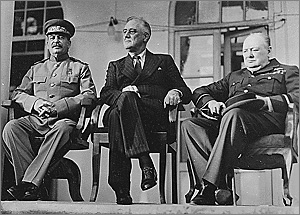
part 1 2 3 4
The Nazis turned Poland into a racial killing ground. Hitler chose Poland for extermination camps like Auschwitz and Treblinka. In Warsaw nearly 400,000 of the city's Jews were first herded into a ghetto and then sent to death camps. In April 1943, the 70,000 that remained in the ghetto decided to die fighting and launched an uprising.
Few survived.
As for the Poles, Hitler described them as, "More like animals than human beings," but by the summer of 1944, the fortunes of war had changed.
As the Allies landed in France on D Day, every bit of news was music to the ears of the Poles. Poland too dreamed of liberation, but unlike the people of Normandy and later Paris, the Poles had to rely entirely on their former enemy, the Soviet Union, who just five years earlier, had carved up their country with the Nazis. It was a huge gamble, but there was nothing they could do. Hitler's surprise attack on the USSR in 1941 had transformed Europe's military alignments overnight.
|  | | Stalin, Roosevelt, and Chirchill in Teheran, Iran, 1943
courtesy: NARA |
Churchill and Roosevelt now needed Stalin to win the war. This was a distressing turn of events for the Poles. Stalin was the man they blamed, and rightly as it turned out, for the murder of thousands of Polish officers in the Katyn forest of Ukraine. However, their constant warnings that the Soviets couldn't be trusted had transformed the Poles from what Western leaders had once described as 'the inspiration of the world,' to a thorn in the side of the Allied camp.
Most Poles believed that the Allies would help them. After all, Poles had played an important part in the Battle of Britain and the battle of Monte Cassino in Italy, as well as other campaigns in Western Europe.
Buoyed by German losses in the East, the Polish government in exile in London was planning an uprising. It was to be a historic gesture, a demonstration that would last a few days if not hours, and re-establish Polish sovereignty over its capital before anyone else did.
Go to part 3
|

